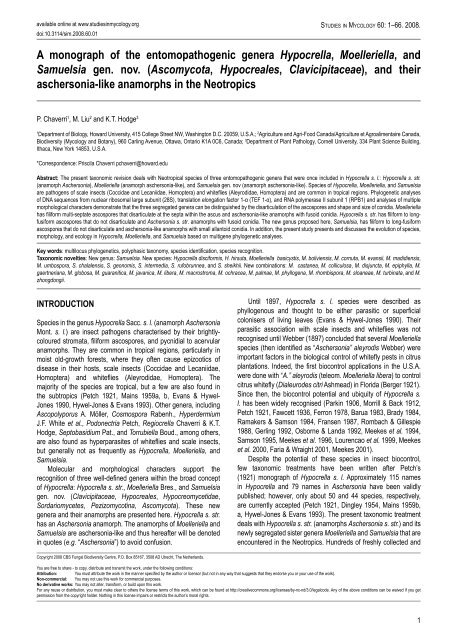Moelleriella, and Samuelsia - CBS
Moelleriella, and Samuelsia - CBS
Moelleriella, and Samuelsia - CBS
- No tags were found...
You also want an ePaper? Increase the reach of your titles
YUMPU automatically turns print PDFs into web optimized ePapers that Google loves.
available online at www.studiesinmycology.orgdoi:10.3114/sim.2008.60.01St u d i es in My c o l o g y 60: 1–66. 2008.A monograph of the entomopathogenic genera Hypocrella, <strong>Moelleriella</strong>, <strong>and</strong><strong>Samuelsia</strong> gen. nov. (Ascomycota, Hypocreales, Clavicipitaceae), <strong>and</strong> theiraschersonia-like anamorphs in the NeotropicsP. Chaverri 1 , M. Liu 2 <strong>and</strong> K.T. Hodge 31Department of Biology, Howard University, 415 College Street NW, Washington D.C. 20059, U.S.A.; 2 Agriculture <strong>and</strong> Agri-Food Canada/Agriculture et Agroalimentaire Canada,Biodiversity (Mycology <strong>and</strong> Botany), 960 Carling Avenue, Ottawa, Ontario K1A 0C6, Canada; 3 Department of Plant Pathology, Cornell University, 334 Plant Science Building,Ithaca, New York 14853, U.S.A.*Correspondence: Priscila Chaverri pchaverri@howard.eduAbstract: The present taxonomic revision deals with Neotropical species of three entomopathogenic genera that were once included in Hypocrella s. l.: Hypocrella s. str.(anamorph Aschersonia), <strong>Moelleriella</strong> (anamorph aschersonia-like), <strong>and</strong> <strong>Samuelsia</strong> gen. nov (anamorph aschersonia-like). Species of Hypocrella, <strong>Moelleriella</strong>, <strong>and</strong> <strong>Samuelsia</strong>are pathogens of scale insects (Coccidae <strong>and</strong> Lecaniidae, Homoptera) <strong>and</strong> whiteflies (Aleyrodidae, Homoptera) <strong>and</strong> are common in tropical regions. Phylogenetic analysesof DNA sequences from nuclear ribosomal large subunit (28S), translation elongation factor 1-α (TEF 1-α), <strong>and</strong> RNA polymerase II subunit 1 (RPB1) <strong>and</strong> analyses of multiplemorphological characters demonstrate that the three segregated genera can be distinguished by the disarticulation of the ascospores <strong>and</strong> shape <strong>and</strong> size of conidia. <strong>Moelleriella</strong>has filiform multi-septate ascospores that disarticulate at the septa within the ascus <strong>and</strong> aschersonia-like anamorphs with fusoid conidia. Hypocrella s. str. has filiform to longfusiformascospores that do not disarticulate <strong>and</strong> Aschersonia s. str. anamorphs with fusoid conidia. The new genus proposed here, <strong>Samuelsia</strong>, has filiform to long-fusiformascospores that do not disarticulate <strong>and</strong> aschersonia-like anamorphs with small allantoid conidia. In addition, the present study presents <strong>and</strong> discusses the evolution of species,morphology, <strong>and</strong> ecology in Hypocrella, <strong>Moelleriella</strong>, <strong>and</strong> <strong>Samuelsia</strong> based on multigene phylogenetic analyses.Key words: multilocus phylogenetics, polyphasic taxonomy, species identification, species recognition.Taxonomic novelties: New genus: <strong>Samuelsia</strong>. New species: Hypocrella disciformis, H. hirsuta, <strong>Moelleriella</strong> basicystis, M. boliviensis, M. cornuta, M. evansii, M. madidiensis,M. umbospora, S. chalalensis, S. geonomis, S. intermedia, S. rufobrunnea, <strong>and</strong> S. sheikhii. New combinations: M. castanea, M. colliculosa, M. disjuncta, M. epiphylla, M.gaertneriana, M. globosa, M. guaranitica, M. javanica, M. libera, M. macrostroma, M. ochracea, M. palmae, M. phyllogena, M. rhombispora, M. sloaneae, M. turbinata, <strong>and</strong> M.zhongdongii.INTRODUCTIONSpecies in the genus Hypocrella Sacc. s. l. (anamorph AschersoniaMont. s. l.) are insect pathogens characterised by their brightlycolouredstromata, filiform ascospores, <strong>and</strong> pycnidial to acervularanamorphs. They are common in tropical regions, particularly inmoist old-growth forests, where they often cause epizootics ofdisease in their hosts, scale insects (Coccidae <strong>and</strong> Lecaniidae,Homoptera) <strong>and</strong> whiteflies (Aleyrodidae, Homoptera). Themajority of the species are tropical, but a few are also found inthe subtropics (Petch 1921, Mains 1959a, b, Evans & Hywel-Jones 1990, Hywel-Jones & Evans 1993). Other genera, includingAscopolyporus A. Möller, Cosmospora Rabenh., HyperdermiumJ.F. White et al., Podonectria Petch, Regiocrella Chaverri & K.T.Hodge, Septobasidium Pat., <strong>and</strong> Torrubiella Boud., among others,are also found as hyperparasites of whiteflies <strong>and</strong> scale insects,but generally not as frequently as Hypocrella, <strong>Moelleriella</strong>, <strong>and</strong><strong>Samuelsia</strong>.Molecular <strong>and</strong> morphological characters support therecognition of three well-defined genera within the broad conceptof Hypocrella: Hypocrella s. str., <strong>Moelleriella</strong> Bres., <strong>and</strong> <strong>Samuelsia</strong>gen. nov. (Clavicipitaceae, Hypocreales, Hypocreomycetidae,Sordariomycetes, Pezizomycotina, Ascomycota). These newgenera <strong>and</strong> their anamorphs are presented here. Hypocrella s. str.has an Aschersonia anamorph. The anamorphs of <strong>Moelleriella</strong> <strong>and</strong><strong>Samuelsia</strong> are aschersonia-like <strong>and</strong> thus hereafter will be denotedin quotes (e.g. “Aschersonia”) to avoid confusion.Until 1897, Hypocrella s. l. species were described asphyllogenous <strong>and</strong> thought to be either parasitic or superficialcolonisers of living leaves (Evans & Hywel-Jones 1990). Theirparasitic association with scale insects <strong>and</strong> whiteflies was notrecognised until Webber (1897) concluded that several <strong>Moelleriella</strong>species (then identified as “Aschersonia” aleyrodis Webber) wereimportant factors in the biological control of whitefly pests in citrusplantations. Indeed, the first biocontrol applications in the U.S.A.were done with “A.” aleyrodis (teleom. <strong>Moelleriella</strong> libera) to controlcitrus whitefly (Dialeurodes citri Ashmead) in Florida (Berger 1921).Since then, the biocontrol potential <strong>and</strong> ubiquity of Hypocrella s.l. has been widely recognised (Parkin 1906, Morrill & Back 1912,Petch 1921, Fawcett 1936, Ferron 1978, Barua 1983, Brady 1984,Ramakers & Samson 1984, Fransen 1987, Rombach & Gillespie1988, Gerling 1992, Osborne & L<strong>and</strong>a 1992, Meekes et al. 1994,Samson 1995, Meekes et al. 1996, Lourencao et al. 1999, Meekeset al. 2000, Faria & Wraight 2001, Meekes 2001).Despite the potential of these species in insect biocontrol,few taxonomic treatments have been written after Petch’s(1921) monograph of Hypocrella s. l. Approximately 115 namesin Hypocrella <strong>and</strong> 79 names in Aschersonia have been validlypublished; however, only about 50 <strong>and</strong> 44 species, respectively,are currently accepted (Petch 1921, Dingley 1954, Mains 1959b,a, Hywel-Jones & Evans 1993). The present taxonomic treatmentdeals with Hypocrella s. str. (anamorphs Aschersonia s. str.) <strong>and</strong> itsnewly segregated sister genera <strong>Moelleriella</strong> <strong>and</strong> <strong>Samuelsia</strong> that areencountered in the Neotropics. Hundreds of freshly collected <strong>and</strong>Copyright 2008 <strong>CBS</strong> Fungal Biodiversity Centre, P.O. Box 85167, 3508 AD Utrecht, The Netherl<strong>and</strong>s.You are free to share - to copy, distribute <strong>and</strong> transmit the work, under the following conditions:Attribution:You must attribute the work in the manner specified by the author or licensor (but not in any way that suggests that they endorse you or your use of the work).Non-commercial: You may not use this work for commercial purposes.No derivative works: You may not alter, transform, or build upon this work.For any reuse or distribution, you must make clear to others the license terms of this work, which can be found at http://creativecommons.org/licenses/by-nc-nd/3.0/legalcode. Any of the above conditions can be waived if you getpermission from the copyright holder. Nothing in this license impairs or restricts the author’s moral rights.1
















